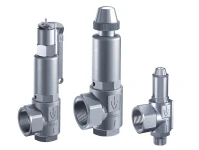- What is a pressure relief valve?
- How is a pressure relief valve constructed?
- How does a pressure relief valve work?
- The challenge of hydrogen
- Which materials are suitable for hydrogen applications?
- Which seals are suitable for H2 applications?
- What should be considered when manufacturing pressure relief valves for hydrogen applications?
- Which approvals for pressure relief valves are necessary in the field of hydrogen applications?
Browse all hydrogen pressure relief valves from leading suppliers on our marketplace!
What is a pressure relief valve?
A pressure relief valve prevents a predefined pressure from being exceeded. When the pressure is exceeded, the valve opens and the excess pressure is released and the medium is discharged. The pressure relief valve is activated without auxiliary energy and is triggered purely by the medium.
As soon as normal working pressure conditions have been restored, the pressure relief valve closes and further outflow of the medium is prevented.
A pressure relief valve is used to protect a system as a last safety instance. In the case of systems requiring approval or systems that fall under the European Pressure Equipment Directive, for example, corresponding tests and approvals are required for the valves.
How is a pressure relief valve constructed?
Even though each series differs in the field of safety valves, the main components of each valve are similar. The optimal design of the component geometry is ensured by flow simulations and elaborate function tests.
How does a pressure relief valve work?
The function of a pressure relief valve can be traced back to a simple balance of forces between the pressure spring force and the medium force.
When at rest and installed on the system in normal operation, the force of the pressure spring is greater than the medium force, whereby the valve is closed and seals to the outside.
If the set pressure of the valve is exceeded due to increased system pressure, the valve opens and allows the pressure to be relieved by the medium escaping. After the pressure in the system has been reduced below the closing pressure, the valve closes tightly again.
The challenge of hydrogen
On the one hand, hydrogen is a colourless, odourless and completely non-toxic gas; on the other hand, it is highly volatile, highly flammable and has a high flame velocity. With hydrogen as a medium, the challenge is to produce, transport, store and use the gas safely, depending on the application and environment. These characteristics of hydrogen pose specific challenges for the design and construction of a hydrogen pressure relief valve.
As the last mechanically acting component in the safety chain, the pressure relief device for hydrogen systems is an important and indispensable part of the process. This applies in particular to the materials and seals used, as well as to the manufacturing process of the hydrogen valve, and the corresponding approvals.
A hydrogen pressure relief valve can be used to safeguard a hydrogen circuit, a hydrogen pressure pipe, or a high pressure hydrogen tank. The final safety chain function of such a high pressure hydrogen relief device is particularly relevant on a compressed hydrogen tank, which needs to maintain safe pressure levels even while the hydrogen system is not in operation, or left unattended.
Which materials are suitable for hydrogen applications?
- Look for high-quality stainless steels.
- Austenitic steels with a nickel content of >10 % have proven themselves.
- With other materials there is a risk of hydrogen-induced stress corrosion cracking (depending on pressure and temperature).
Which seals are suitable for H2 applications?
Pressure, temperature, permeation (diffusion) play an important role here. Pay attention to the NORSOK standard M-710 for elastomer sealing materials.
What should be considered when manufacturing pressure relief valves for hydrogen applications?
- Set high standards for cleaning requirements
- Oil- and grease-free production, a hydrogen purity of > 5.0 (> 99.999 %), production according to a special production process for technical gases is explicitly recommended.
- In a so-called clean room with 20 millibar overpressure, the valves are produced free of oil and grease according to a controlled process.
- The test medium is specially cleaned by activated carbon filters.
Which approvals for pressure relief valves are necessary in the field of hydrogen applications?
- Even though there are currently no specific H2 approvals yet, relevant guidelines and best practices have been established, for example High Pressure Hydrogen Pressure Relief Devices: Accelerated Life Testing and Application Best Practices” (National Renewable Energy Laboratory), 2017
- Only use component-tested pressure relief valves to protect your hydrogen pressure systems.
- Sound technical advice from the valve manufacturer of the high pressure hydrogen relief device is essential in any case. Only then can your specific conditions be taken into account and the hydrogen pressure relief valve can be correctly designed according to the conditions prevailing on site.
Content contributed by Goetze KG Armaturen
For over 70 years, Goetze KG Armaturen has been manufacturing sophisticated high-performance valves and fittings for media under pressure: liquids, air, gases and vapours. The family-owned company, which is based in Ludwigsburg, has made themselves a reputation worldwide with their high level of quality “Made in Germany”. Goetze is your partner regarding safety (valves). We assure the handling of hydrogen from the retrieval to the application – either in the electric part of the process or at the hydrogen filling station for vehicles. We protect filling processes, which are under high pressure or the storage of liquid hydrogen in tanks.
Last update: 15.1.2023










